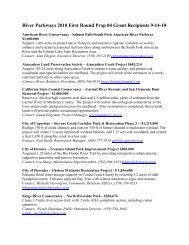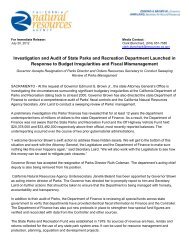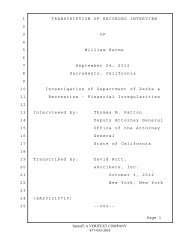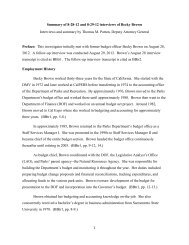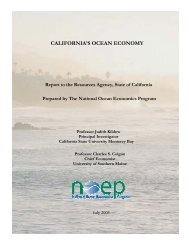california river parkways grant program - California Resources Agency
california river parkways grant program - California Resources Agency
california river parkways grant program - California Resources Agency
Create successful ePaper yourself
Turn your PDF publications into a flip-book with our unique Google optimized e-Paper software.
Sample Eligible and Ineligible Projects<br />
Eligible River Parkways Projects - The items below provide examples of project<br />
elements that meet statutory conditions. (This is not a comprehensive list.)<br />
Recreation<br />
• Create or expand trails for walking, bicycling and/or equestrian activities that are<br />
compatible with other conservation objectives.<br />
• Improve existing <strong>river</strong> <strong>parkways</strong> by providing amenities such as picnic and rest areas,<br />
shade ramadas, etc.<br />
• Provide <strong>river</strong> access for non-motorized activities such as fishing, canoeing, etc.<br />
• Acquire property along a <strong>river</strong> to be used for compatible recreational opportunities<br />
such as picnics, nature viewing, etc.<br />
• Relocate or reconstruct existing trails to correct environmental damage.<br />
Habitat<br />
• Convert channelized streams or <strong>river</strong>s to a more historical flow pattern that will<br />
promote the structure, function and dynamics of Riparian and Riverine habitat.<br />
• Acquire land that will be managed to increase the size and quality of existing Riparian<br />
Habitat.<br />
• Remove exotic and/or invasive plants along stream corridors that damage habitat.<br />
• Plant appropriate native trees, shrubs, and plants to restore or improve the <strong>river</strong><br />
parkway’s biological habitat.<br />
Flood Management – as part of a flood management plan or flood management project<br />
• Expand existing River Parkway by acquiring adjacent lands to accommodate periodic<br />
flooding.<br />
• Restore land to natural floodplain forms, including wetland areas that will<br />
accommodate periodic flooding.<br />
• Acquire streamside parcels that have historically flooded to become a River Parkway.<br />
Conversion to River Parkways<br />
• Convert <strong>river</strong>front land from industrial use into public multi-use areas such as<br />
floodplains, wetlands, public trails, etc.<br />
• Revitalize urban neighborhoods by removing abandoned structures along the <strong>river</strong>front<br />
to provide open space with <strong>river</strong> access for the public.<br />
• Acquire commercial or agricultural property along a <strong>river</strong>front to expand existing River<br />
Parkways.<br />
Conservation and Interpretive Enhancements<br />
• Construct an overlook area for a restored wetland with interpretive signage, where the<br />
public can observe the project benefits.<br />
• Construct a boardwalk adjacent to sensitive habitat to allow public viewing without<br />
disturbing flora or fauna.<br />
• Develop open-space areas such as demonstration gardens/basins that illustrate<br />
restoration/conservation project benefits.<br />
• Provide informational displays, interpretive kiosks and signage to present<br />
information/maps about the River Parkway, its restoration projects, wildlife, etc.<br />
• Construct small scale structures designed to secure kiosks and displays.<br />
Ineligible River Parkways Projects/Applications – The items<br />
below provide examples of projects and elements NOT funded<br />
under this <strong>program</strong>. (This is not a comprehensive list.)<br />
• Projects with no <strong>river</strong> or stream linkage.<br />
• Projects that include acquisition of property that cannot be<br />
purchased at fair market value.<br />
• Planning only, or operations and maintenance projects.<br />
• Programmatic projects, such as education and outreach.<br />
• Projects that exclusively fulfill mitigation requirements.<br />
• Active recreation projects (including playgrounds, skateboard<br />
parks, basketball courts and ball fields).<br />
• Recreational activities not compatible with the specific<br />
environment or location in which they are situated.<br />
• Projects that upgrade, expand or facilitate motorized use of<br />
trails (even when used by non-motorized trail users).<br />
• Projects that create or improve roads for motorized use.<br />
• Projects that will not be completed in the allotted timelines.<br />
• Parking lots, bridges or infrastructure. (Parking areas,<br />
bridges or infrastructure may be funded only as a necessary<br />
but minor component of the project to make the River<br />
Parkway accessible to the public.)<br />
• Dredging behind dams to reduce siltation, or other purposes.<br />
• Projects that construct multiple-use buildings, educational<br />
facilities or regional community centers.<br />
• Renovation/restoration of structures on converted <strong>river</strong>front<br />
land.<br />
• Development projects contingent on future acquisition for<br />
project implementation.<br />
• Projects that include both acquisition and development<br />
(project must be one or the other, not both.)<br />
• Projects that attempt to meet one of two statutory conditions<br />
with landscaping instead of restoration. (Landscaping may<br />
be funded only as a minor component of a larger project that<br />
meets two statutory conditions.)<br />
• Projects that are intended to correct problems caused by<br />
inadequate maintenance.<br />
• Applications that include more than one project.<br />
2



